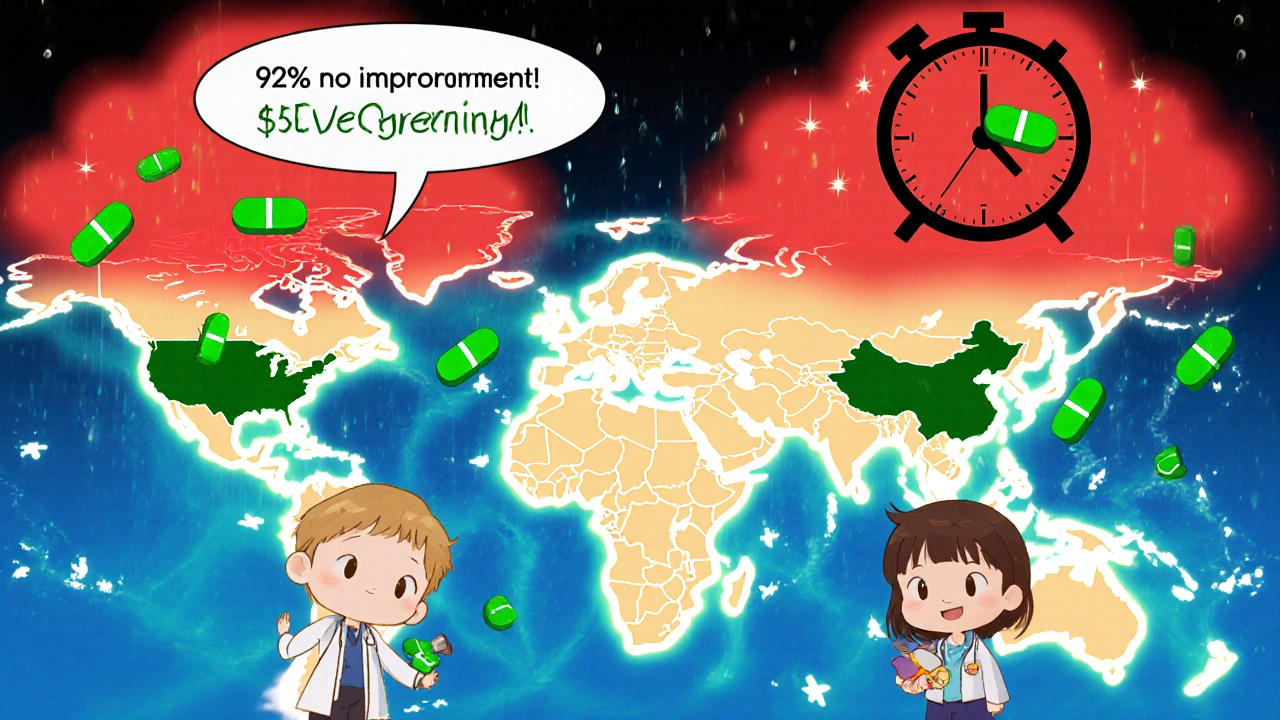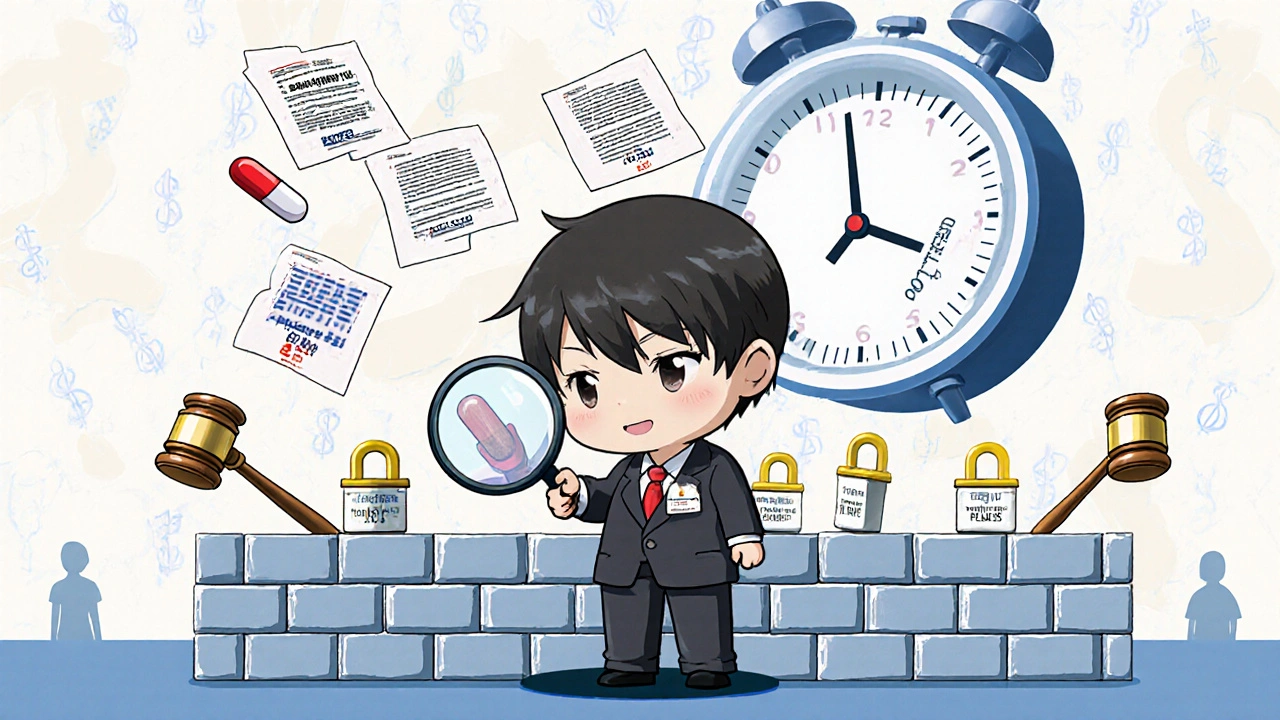When a blockbuster drug’s patent runs out, generic versions should flood the market-prices drop by 80%, and patients get affordable access. But in reality, that rarely happens on time. Instead, big pharma companies use a playbook called evergreening-a set of legal and technical tricks to delay generic competition, often for years or even decades.
What Evergreening Really Is
Evergreening isn’t about inventing new medicines. It’s about making tiny changes to existing ones-changing the pill shape, tweaking the dosage, switching from a tablet to a capsule, or combining two old drugs into one new package-and then filing a new patent. These aren’t breakthroughs. They’re minor tweaks, sometimes with no real benefit to patients. But under current patent law, they’re enough to reset the clock on exclusivity. The strategy took off after the 1984 Hatch-Waxman Act in the U.S., which created a fast track for generic drugs but also gave brand-name companies extra protections. Companies quickly learned how to exploit it. Instead of spending billions on new drug discovery, they started investing in patent lawyers and formulation scientists to squeeze every last year of profits from drugs that were already on the market.How It Works: The Playbook
There are several well-documented tactics used in evergreening:- Product hopping: A company stops selling the original drug and pushes patients onto a slightly modified version. AstraZeneca did this with Prilosec (omeprazole) and Nexium (esomeprazole). Nexium wasn’t better-it was just the single-isomer version of the same molecule. But by switching, they extended patent life by over a decade.
- Patent thickets: Rather than file one patent, companies file dozens. AbbVie filed 247 patents on Humira (adalimumab), a drug for rheumatoid arthritis. Over 100 were granted. Generic makers can’t afford to challenge them all, so they wait-or give up.
- Orphan drug and pediatric extensions: If a drug is repurposed for a rare disease or tested in children, companies get extra years of exclusivity-even if the original use was for something common like high blood pressure.
- Authorized generics: The brand company itself launches a cheaper version under a different label. This blocks independent generics from entering, because pharmacies can just buy the cheaper branded version instead.
- OTC-switching: When a drug’s patent nears expiration, the company repositions it as an over-the-counter medicine. This avoids generic competition entirely by moving it out of the prescription market.
Why It’s a Problem
The cost isn’t just financial-it’s human. When a drug like Humira or Nexium stays under patent, patients pay $5,000 to $10,000 a year. Generics cost $500. That’s not a price difference-it’s a life-or-death gap. Millions of people with autoimmune diseases, diabetes, or acid reflux can’t afford treatment. Some skip doses. Others don’t fill prescriptions at all. Health systems pay the price too. Medicare and private insurers spend billions more because generics aren’t allowed to compete. A 2015 study found that generic competition typically cuts drug prices by 80-85% within a year. Evergreening blocks that savings. And it’s not innovation. It’s arithmetic. Developing a new drug takes 10-15 years and costs $2.6 billion. Evergreening? A few million in legal fees and a small clinical trial. The return on investment? Huge. The value to patients? Often zero.
Who’s Doing It-and Who’s Fighting Back
AstraZeneca, AbbVie, Pfizer, and Johnson & Johnson are among the biggest users of evergreening. But it’s not just big names. Dozens of companies use it. Harvard researchers found that 78% of new patents on prescription drugs were for existing ones-not new molecules. The backlash is growing. In 2022, the U.S. Federal Trade Commission sued AbbVie over Humira’s patent strategy, calling it an illegal monopoly. The Inflation Reduction Act of 2022 gave Medicare the power to negotiate prices for the most expensive drugs, which weakens the financial incentive for evergreening. The European Medicines Agency now demands proof of “significant clinical benefit” before granting extra exclusivity. In India and Brazil, regulators have cracked down harder. They refuse to grant patents on minor modifications. Generic manufacturers there are already producing affordable versions of drugs that remain expensive in the U.S. and Europe.The Bigger Picture: Innovation vs. Profit
Pharma companies argue that evergreening funds future innovation. But the data doesn’t support it. The money spent on patent thickets and product hopping isn’t going into R&D for new cures-it’s going into legal teams and marketing campaigns. Real innovation happens when companies invest in entirely new targets: gene therapies, mRNA platforms, or drugs for rare diseases with no existing treatment. Evergreening doesn’t help those efforts. It distracts from them. The system was meant to balance access and incentive. But today, the scale is tipped hard toward profit. Patients don’t need more versions of the same pill. They need more affordable options.
What’s Next?
The next wave of evergreening might involve biologics, nanotech formulations, or pharmacogenomic tests. Companies are already patenting genetic tests that predict whether a patient will respond to a drug-then tying that test to the branded version. If you don’t take the test, you can’t get the drug. That’s not medicine. It’s a legal lock. But change is coming. More lawmakers are asking: Why should a company get 30 years of monopoly on a drug that was approved 20 years ago? Why should a child with asthma pay $600 for an inhaler when the active ingredient has been around since the 1970s? The answer, for now, is: because the rules let them. But those rules are being tested-in court, in Congress, and in pharmacies where patients are choosing between rent and their medication.What You Can Do
If you or someone you know relies on expensive brand-name drugs:- Ask your doctor if a generic is available-even if the brand says it’s not. Sometimes generics exist but aren’t promoted.
- Check Patient Assistance Programs. Many drugmakers offer discounts or free meds to low-income patients.
- Support policy changes that limit evergreening. Groups like Public Citizen and Health Care for All track these issues and push for reform.
- Don’t assume “newer” means better. A 2023 study showed that 92% of “new” versions of old drugs offered no measurable improvement in patient outcomes.
Is evergreening legal?
Yes, for now. Evergreening exploits legal loopholes in patent and drug approval systems. While it’s not illegal per se, many of its tactics-like patent thickets and product hopping-are being challenged in court and by regulators. The U.S. Federal Trade Commission has sued companies like AbbVie for anticompetitive behavior, and courts are increasingly skeptical of patents on minor drug modifications.
How long can a drug stay protected through evergreening?
Normally, a drug patent lasts 20 years from filing. But with evergreening, total exclusivity can stretch to 30, 35, or even 40 years. Humira’s patent portfolio extended its market exclusivity until 2023-nearly 23 years after its initial approval. AstraZeneca’s strategy added over 90 years of combined exclusivity across six drugs.
Do evergreened drugs work better than generics?
Almost never. Studies show that 92% of modified versions of existing drugs offer no meaningful improvement in effectiveness, safety, or patient outcomes. Nexium wasn’t more effective than Prilosec. Suboxone film wasn’t better than the original tablet. The changes are often cosmetic or logistical-not therapeutic.
Why don’t generic companies just copy the drug?
They try-but they’re blocked by patent thickets. If a company files 50 or 100 patents on a single drug, generic makers face legal costs in the millions just to challenge them. Many can’t afford it. Others wait until the last patent expires, which can take over a decade.
Are there countries that stop evergreening?
Yes. India, Brazil, South Africa, and Thailand have strict rules against granting patents on minor modifications. India’s patent office routinely rejects applications for “evergreened” versions of drugs. As a result, these countries have some of the lowest drug prices in the world and are major suppliers of generic medicines globally.
Can Medicare negotiate prices to stop evergreening?
The Inflation Reduction Act of 2022 lets Medicare negotiate prices for 10 high-cost drugs per year, starting in 2026. While it won’t kill evergreening outright, it reduces the financial payoff. If a company can’t charge $100,000 a year for a drug, the incentive to extend patents with tiny changes weakens significantly.

11 Comments
Pawan Jamwal
Bro, India has been laughing at these pharma scams for decades. We make generics so cheap, even Walmart buys from us. U.S. pays $10k for Humira? LOL. We pay $5. 🤡💊
Bill Camp
THIS IS WHY AMERICA IS DYING. Big Pharma owns Congress. They’re not just making profits-they’re stealing lives. I’ve seen people skip insulin. This isn’t capitalism. This is feudalism with IV drips. 🇺🇸💔
Sarah Swiatek
It’s fascinating how the system was designed to incentivize innovation, but instead became a playground for legal gymnastics. The Hatch-Waxman Act was meant to balance access and reward-but it didn’t account for human greed dressed up as ‘intellectual property.’ The real tragedy isn’t the patents; it’s that we’ve normalized this as ‘business as usual.’ We’ve forgotten that medicine is a human right, not a shareholder’s spreadsheet. And now we’re surprised when people die because they can’t afford a pill that costs pennies to produce? The moral bankruptcy is staggering.
Dave Wooldridge
EVERYTHING IS A COVER. Big Pharma is working with the FDA, the WHO, even the WHO. They’re pushing this so you’ll get addicted to overpriced pills so they can sell you the ‘new version’ every 5 years. They’re not even trying to cure you-they want you dependent. They’re poisoning the water supply with marketing. It’s all a psyop. 🕵️♂️💉
Rebecca Cosenza
People who pay $10k for a drug are just as guilty as the companies. You could’ve asked. You could’ve researched. You didn’t. 😒
swatantra kumar
India’s patent office is the real MVP here. 🇮🇳🔥 They look at a ‘new’ pill and say ‘lol no’ instead of writing a check. Meanwhile, the U.S. pays for patents on changing the color of a capsule. We need global standards. Or at least, let the rest of the world save lives while America argues about trademarks. 🤷♂️💊
Cinkoon Marketing
It’s wild how the same people who scream ‘free market!’ when it comes to iPhones are totally fine with pharma monopolies. The inconsistency is almost poetic. I mean, if competition drives innovation, why does the drug market have zero competition for 20+ years? 🤔
robert cardy solano
My cousin’s on Humira. She got the generic last year. Cost dropped from $7k/month to $400. She cried. Not because she was happy-because she realized she’d been overpaying for 8 years. And nobody told her. That’s the real crime.
Lemmy Coco
i never knew about product hopping til i read this. like… so they just stop selling the old drug and say ‘hey this new one is better’ but its the same chem? that’s wild. i feel like my dr could’ve told me that… oops
rob lafata
You people are naive. This isn’t about ethics-it’s about power. Pharma doesn’t care if you live or die. They care about your insurance ID. The real villains aren’t the CEOs-they’re the middle-class suckers who vote for politicians who take their money and then pretend to care. You want change? Stop being a passive consumer. Start burning down the system. Or keep paying $600 for an inhaler. Your choice.
serge jane
What’s interesting is how we’ve conflated innovation with commercial success. We reward the ability to navigate bureaucracy better than anyone else-not the ability to heal. We’ve built a system that honors legal cleverness over medical truth. And we wonder why trust in medicine is collapsing. It’s not because of misinformation. It’s because patients can see the math. And the math says: you’re being played. The real question isn’t whether evergreening is legal-it’s whether we’re still a society that believes in justice, or just in profit margins.